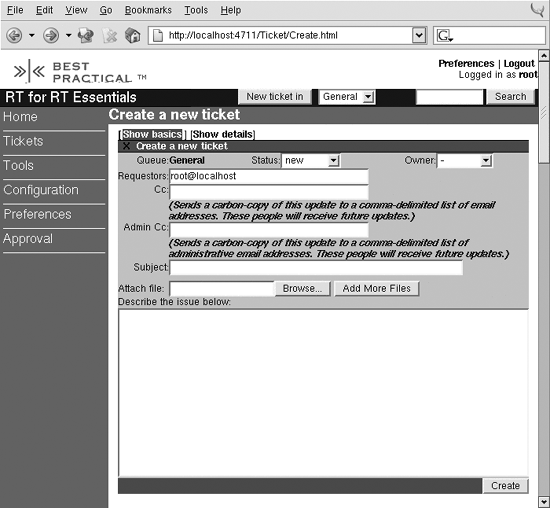3.2. Creating a New Ticket
| < Day Day Up > |
| You can create a ticket from anywhere in RT; the top of every page has a small form with a button labeled New Ticket in and a drop-down menu listing the queues you can access. Select the queue in which you want to create a new ticket, and click the New Ticket in button. It will take you to the new ticket form shown in Figure 3-3. Figure 3-3. Create a new ticket (basic) The two most important fields in this basic form are the subject of the ticket and an entry box for a description; these are the first items that people see when they look at your ticket. The subject is displayed on the main page with no context, so you should make sure that it is clear and concise. The description field is the primary explanation for what the ticket is about, so you should take care to include all the relevant information. Also keep in mind how the description will be used. For example, tickets created in an Emergency queue outside of business hours might send a message to the on-call operator's SMS device. A ticket that does not get to the point within the SMS character limit will be pretty frustrating for everyone involved. Fill in all the appropriate details, click the Create button, and you'll have a new ticket. Congratulations! There is a quick ticket creation box at the bottom of the home page that instantly creates a new ticket with an empty description. Tickets are identified by number. On a fresh install, the first ticket you create is numbered 1. Every new ticket after that gets a number one higher than the previous ticket. If your RT instance is configured to send mail when a ticket is created (as it is by default), then you should get an email message shortly with a summary of the ticket you created. This message tells you the number that was assigned to the new ticket and provides a URL to the ticket display form. Keep this URL, as you'll need it shortly. When a new ticket is created, RT may run some user-defined actions called scrips. These scrips can do almost anything, but the most common type of scrip sends mail to the queue's watchers informing them of the new ticket. Other scrips might send a notification to an alphanumeric pager, post a message to an IRC channel, or even print the ticket's info to a local line printer. You can read more about scrips in Chapter 5. |
| < Day Day Up > |
EAN: 2147483647
Pages: 166
- Challenging the Unpredictable: Changeable Order Management Systems
- Enterprise Application Integration: New Solutions for a Solved Problem or a Challenging Research Field?
- Context Management of ERP Processes in Virtual Communities
- Distributed Data Warehouse for Geo-spatial Services
- A Hybrid Clustering Technique to Improve Patient Data Quality